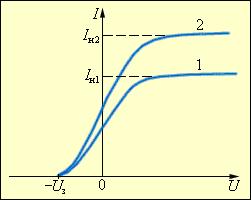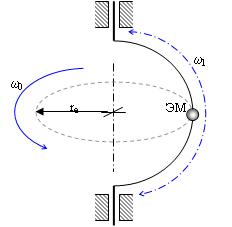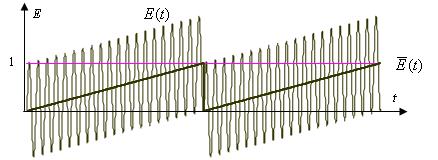Exit "found" Albert Einstein, who proposed the corpuscular model of light and quantum description of the effect. He wrote as follows:


Here A is the work function of the photocathode material, which determines the photoelectric threshold.
This formula was given the name of the author and, along with the Compton effect is obvious manifestation and even proof of the corpuscular light.

Fig.1. The dependence of the strength of the photocurrent on the applied voltage. Curve 2 corresponds to a greater intensity of the light flux. In1 In2 and - current saturation, Uz -stopping potential
Numerous experimenters established following the basic laws of the photoelectric effect:
1. The maximum kinetic energy of photoelectrons increases linearly with the frequency of light? and does not depend on its intensity.
2. For each substance, there is the so-called red edge of the photoelectric effect, ie the lowest frequency? min, on which still possible photoelectric effect.
3. The number of photoelectrons, light ejects from the cathode in 1 s, is directly proportional to light intensity.
4. The photoelectric effect is practically without inertia, the photocurrent occurs immediately after the illumination of the cathode, provided that the light frequency v> vmin.
All these laws of the photoelectric effect are fundamentally contrary to notions of classical physics of the interaction of light with matter. According to the wave representations: an electron interacting with an electromagnetic light wave would be gradually accumulate energy, and would require considerable time, depending on the intensity of light for gaining by the electron enough energy to fly away from the cathode.
Criticism
of modern
concepts.
Before considering this decision, we must consider the physical nature of the product hv. In [1, 2] is shown that the Planck constant comes from the electron, and this is due to its structure.

Fig.2. The structure of electron, providing all its features.
 meridian
itself
rotates
around the axis of symmetry
with a
frequency
meridian
itself
rotates
around the axis of symmetry
with a
frequency
 .
Linear orbital velocity of EM equals to
.
Linear orbital velocity of EM equals to  .
.The energy of the meridional oscillations is equal in each period of Ее (Fig 3). For a complete turnover of these oscillations 137.039. We can characterize the integral vibrational energy of the EM only in the full cycle of the orbital rotation. Therefore, if the average energy of one vibration is the average during the period of the meridional frequency
 ,
,
 .
.
Fig.3. Current average value of electron energy in period.
We can easily calculate the orbital period
 s.
s. .
.Any use of this formula to a massless particle - is quackery. At best - disinterested stupidity.
-But, Einstein's formula well describes the effect itself, - the reader will object.
-Well, well! Nobody objects, only instead of inventing something, we must act according to logic.
So, turn on the rules of scientific methodology: tabulate the possible methods of energy transfer.
Table 1.
| Energy transfer method | Ek=mv2/2 | Q=cM | qU | PV |
| comment | Neutral body | Heat | Charged body | Wave of pressure |
| Where is energy of light? | NO | NO | NO | YES |
Table 1 shows
that the
light has the unique
ability
of energy
transfer, the pressure
wave
PV.
The
product of PV
is
telling us that this requires
constant
specific
volume. And in combination with
Einstein's
equation provides a SINGLE POSSIBLE
way
for the
transmission of light-

